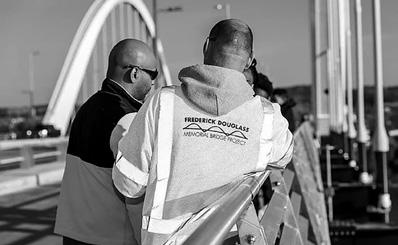
5 minute read
INNOVATIVE WORKFORCE TRAINING PROGRAMS
Provide Opportunities
There is a growing disconnect between the rising number of available construction jobs and the skillsets of the populace. It’s a particular concern in economically underserved areas. Anticipating and understanding that need, the District Department of Transportation invested in three workforce development programs during the Frederick Douglass Memorial Bridge project:

• Construction Management Training Program (CMTP): A field service and classroom curriculum that provides accelerated instruction and opportunities for District residents with little to no experience in high demand jobs to earn certifications and increase chances of employment in construction management.
• STRIVE Program: A six-week, hands-on mentoring program that exposed District high school students with a proven affinity for STEM education to key discipline areas in heavy civil engineering.
• Jobenomics DC: A 10-week, grassroots program focused on basic job skills and heavy civil training to connect residents in the most impoverished communities in the District of Columbia to construction jobs and startup businesses.
CMTP has been unquestionably impactful. For Jon Whitney, HNTB senior project manager, it wasn’t his first experience with the program. HNTB partnered with DDOT to develop the program during the 11th Street Bridge Project to provide a practical pathway to employment for those expressing interest in construction but lacking access to training.

Today, CMTP is a more polished version of itself. “It has been standardized, so that no matter who is doing the program they can easily pick it up and run with it,” Whitney said.
Gary Olson, who comes from a family of teachers, ran the program for HNTB at the Frederick Douglass Memorial Bridge site.

“While it’s not unusual for a construction project to include an on-the-job training program, it’s typically geared toward laborers, carpenters, cement masons, etc.,” said Olson. “They are not typically training for those on the quality assurance side of the table.”
During the training, CMTP accelerates instruction and opportunities for certifications in concrete, soils and aggregate compaction, safety and flagging and pavement marking to minorities, women, and individuals from underserved communities interested in the infrastructure construction industry. Students also can acquire ACI Concrete Field Testing and Soils and Aggregate Compaction Technician certifications.
Participants receive in-class training, and they spend time shadowing workers and inspectors in the field, receiving mentorship and ample exposure to on-site concrete applications such as retaining wall placements and approach slab construction. Following the preparatory training, participants take the certification exams in the areas of study.
Cherie Gibson, HNTB outreach and communications manager, says HNTB partners with several workforce development groups, including The Department of Employment Services, the Department of Veteran Affairs and DDOT, to find the participants.
“We let them know when we’re ready to gear up for a new class, and they help us get the word out,” Gibson said. “They also refer people to us.”
From there, the applicants participate in a screening process. “We give them a rudimentary math test to make sure they are capable of doing the math to pass the certification as well as a reading component,” Whitney said.
It’s an eight-week, intensive class and field training program. Students are paid two stipends, one in the middle of the program and one at the end. They’re also provided with safety gear and access to transportation to the classes. That enables them to continue to pay their bills while participating in the program. The program pays for the certification classes and testing as well.
DDOT’s Dennis Howland, program manager for the South Capitol Street Corridor Program, is encouraged by the success of the program.
“We’re seeing the fruits of the CMTP training on the 11th Street program, as many are all still involved in the industry,” Howland said. “We aren’t just building a bridge. We want to leave a legacy by contributing to a growing skilled workforce in the District, who will be trained and ready to work on all types of construction projects. It’s not just about jobs. We want to help build careers.”
There have been some unexpected outcomes as well. Along the way, the team developed a deeper understanding of the challenges that many area residents must overcome.
“Some of them experience homelessness or have been hospitalized, had COVID or other personal issues,” Gibson said. “Being able to respond and be flexible to their needs has to be built into any program.”
Howland agreed, “The problem is more than just exposure to the jobs and opportunities. Participants might need a driver’s license, a resume or even an address. There are a lot of complex social issues that fog a person’s vision and cloud their understanding of the opportunities that are available.”
In addition to CMTP, additional programs like STRIVE and Jobenomics DC are part of DDOT’s efforts to create opportunities and help people find lasting careers in construction.
“Workforce development is crucial to the success of projects and will be for the next couple of decades,” Howland said.
Working together
Co-location was critical in the beginning. The collaborative atmosphere that sprang from the project’s early days proved vital, as numerous changes would ultimately need to be incorporated into the design.
The in-person meetings morphed into Zoom and Microsoft Teams meetings when the pandemic hit. “Co-locating was still going on. It just moved to our desktops,” Howland added.
“We brought everyone to the table to make changes happen quickly and efficiently, and it involved a lot of give and take,” Navin Jain, HNTB deputy program manager and contract manager, said.
When the pandemic hit, the collaborative approach proved beneficial once again, as the team quickly pivoted to take advantage of lighter traffic and implemented extended lane closures to expedite construction.
“Many of the work restrictions were lifted,” Whitney says, “so that helped the design-builder significantly advance the project during the lockdown.”
And when supply chain issues threatened to drag the project mid-way through the schedule like many construction projects, HNTB took a hands-on approach by directly coordinating the DDOT approval process for long-lead items to ensure timely deliveries.
“We proactively worked with the contractor to help them expedite that process,” Jain says.
When utility relocations threatened to significantly impact the schedule, the team came together to resequence the project to keep it moving. And when one of the bridge’s iconic arches was ¾-inch out of tolerance, with five segments already in place, everyone came together to work a solution.
“Everyone pitched in, left their egos at the door and made the best decisions,” Howland says.
A purposeful approach
A stakeholder communications committee comprised of at least 25 community representatives, was created to address any potential community-related issues while working across such a heavily populated area of the city there are major league baseball and soccer stadiums, a military facility and residential areas in close proximity to the job site.
The group met quarterly in the project office, during which HNTB would provide updates and receive feedback regarding issues and concerns. In the process, committee members would frequently become advocates for the project.
The committee’s impact on the project was undeniably far reaching.
“They brought some great ideas to the table,” Whitney said. “For instance, there’s some very intricate landscaping and hardscaping in these large open spaces within the ovals on either side of the bridge, and they wanted to know who was going to maintain those areas.”
While it wasn’t part of the original contract, the team found a way to include an irrigation system in the contract through negotiations between the designbuilder and DDOT.
They also incorporated a butterfly garden at the committee’s request.
“In the end, the stakeholder communications committee provided a great way for them to feel connected to the project. It was a great way to engage the stakeholders, and it produced some very real benefits,” Whitney said. n
CONTACT
JON WHITNEY, HNTB Senior Project Manager (703) 969-8264 n jwhitney@hntb.com









